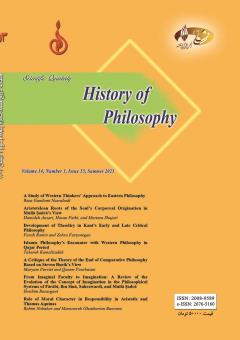From Imaginal Faculty to Imagination: A Review of the Evolution of the Concept of Imagination in the Philosophical Systems of Fārābī, Ibn Sīnā, Suhrawardī, and Mullā Ṣadrā
Subject Areas : Comparison of philosophical thoughts within the Islamic tradition
1 - Assistant Professor, Higher Education Institute of Islamic Art and Philosophy, Qom, Iran
Keywords: Imagination, imagined, world of Ideas, imitative forms, mimesis, Fārābī, Ibn Sīnā, Suhrawardī, Mullā Ṣadrā,
Abstract :
Imagination is one of the human perceptive faculties that is shared with animals. This concept, which has been transferred from Greek philosophy to Muslims’ philosophical tradition, has always been a very important problem with various functions in the self-knowledge of Muslim philosophers from Fārābī to Mullā Ṣadrā. It has even been used in responding to some kalāmī inquiries. Since the very beginning, Muslim philosophers have continuously devoted some of their studies to the investigation and explanation of the whatness and howness of the concept of imagination. However, this concept has not remained immune against change and has developed a distinct meaning in each philosophical system. In the history of Islamic philosophy, the three-fold schools of philosophy (Peripatetic philosophy, Illuminationist philosophy, and the Transcendent Philosophy) have each adopted a particular and different approach to this problem. The present study intends to examine the theories of some great figures of Islamic philosophy regarding the whatness of the faculty of imagination and reveal the existing differences among them. The findings indicate that philosophers’ views of the concept of imagination have not been fixed and similar in the course of history, and each has presented a specific and innovative explanation of this concept in conformity with their own philosophical system. For example, Fārābī considered this faculty to be a material component of the soul, while Mullā Ṣadrā changed it into the world of Ideas. This study was conducted following a descriptive-comparative method using library resources.
ابنسینا (1375) الإشارات و التنبیهات، قم: البلاغة.
ابنسینا (1404) الشفاء، النّفس، تصحیح سعید زائد و دیگران، بیروت: موسسة الجامعیة للدراسات الاسلامیة.
اکبریان، رضا (1388) «قوه خیال و عالم صور خیالی»، آموزههای فلسفی-کلامی، شماره 8، ص 33ـ 3.
سهروردی (1380) مجموعه مصنفات شیخ اشراق، جلد 1 و 2، تهران: پژوهشگاه علوم انسانی و مطالعات فرهنگی.
شهرزوری، محمد بن محمود (1380) شرح حکمةالاشراق، تصحیح حسین ضیائی، تهران: پژوهشگاه علوم انسانی و مطالعات فرهنگی.
شیرازی، قطبالدین محمود بن مسعود (1383) شرح حکمة الإشراق، تصحیح عبدلله نورانی و مهدی محقق، تهران: انجمن آثار و مفاخر فرهنگی.
فارابی (1421) السیاسة المدنیة، تصحیح علی بوملحم، بیروت: دار و مکتبة الهلال.
فارابی (1995) آراء اهل المدینة الفاضلة و مضاداتها، تصحیح علی بوملحم، بیروت: دار و مکتبة الهلال.
ملاصدرا (1381) المبدأ و المعاد فی الحکمة المتعالیة، ج2، تصحیح و تحقیق محمد ذبیحی و جعفر شاهنظری، تهران: بنیاد حکمت اسلامی صدرا.
ملاصدرا (1383) الحکمة المتعالیة فی الأسفار الأربعة، ج1، تصحیح و تحقیق غلامرضا اعوانی، تهران: بنیاد حکمت اسلامی صدرا.
ملاصدرا (1383) الحکمة المتعالیة فی الأسفار الأربعة، ج8، تصحیح و تحقیق علیاکبر رشاد، تهران: بنیاد حکمت اسلامی صدرا.
ملاصدرا (1383) الحکمة المتعالیة فی الأسفار الأربعة، ج9، تصحیح و تحقیق رضا اکبریان، تهران: بنیاد حکمت اسلامی صدرا.
ملاصدرا (1386) مفاتیح الغیب، ج1، تصحیح و تحقیق نجفقلی حبیبی، تهران: بنیاد حکمت اسلامی صدرا.


